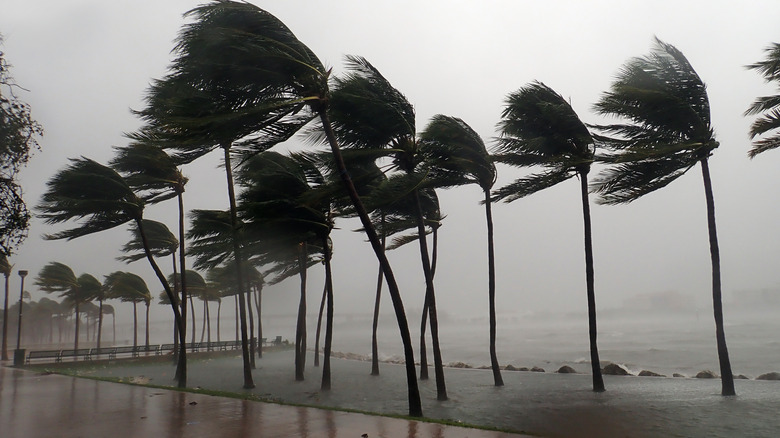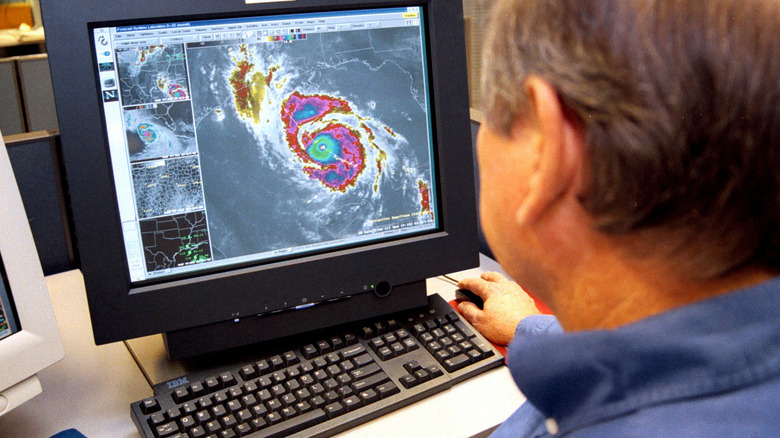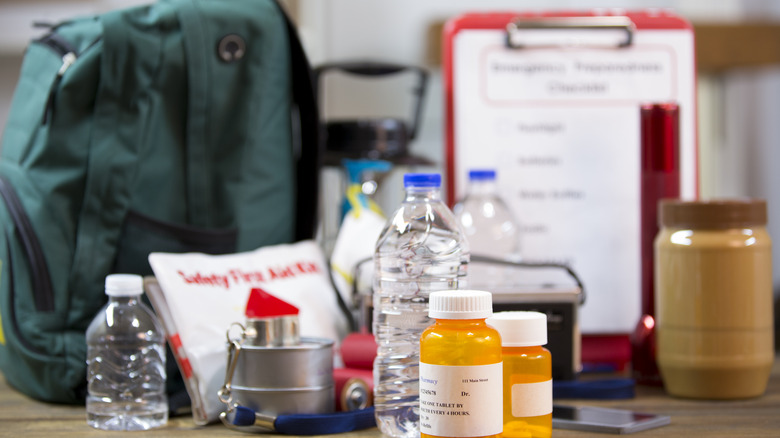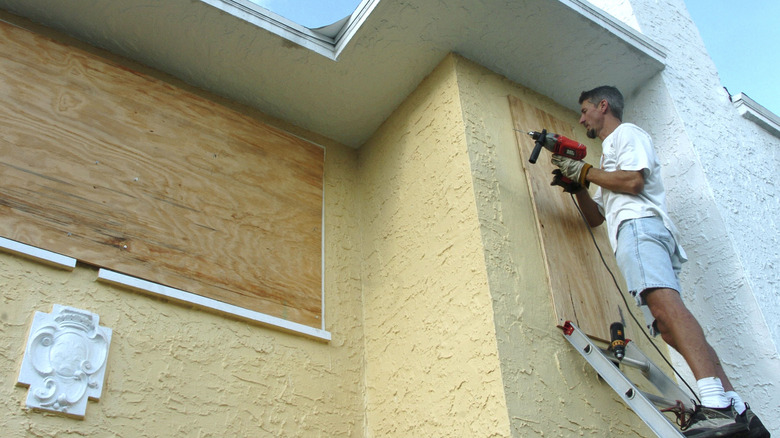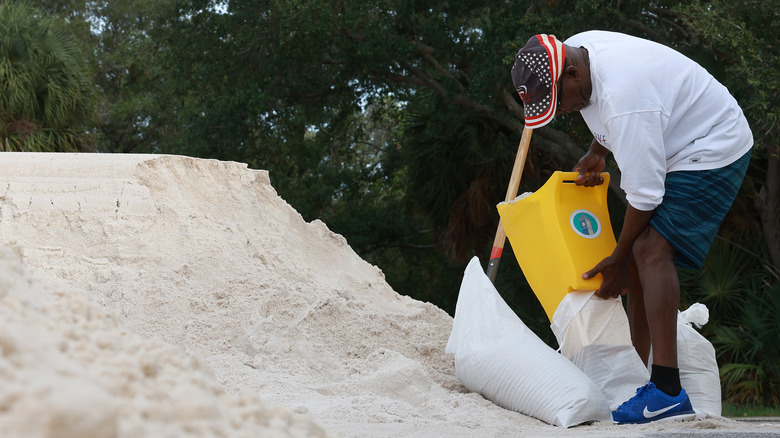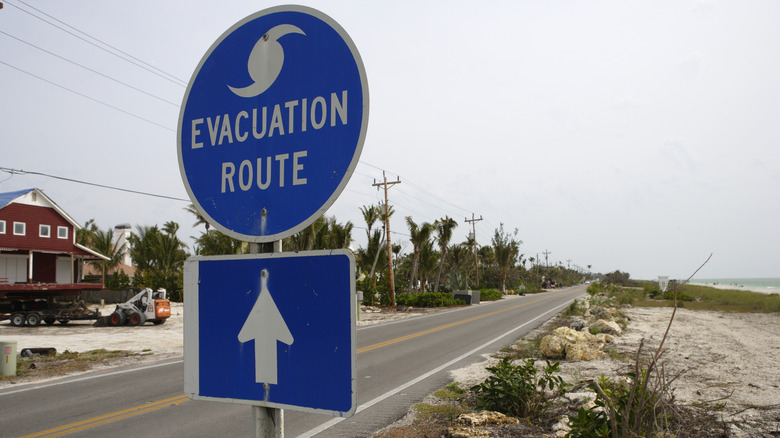How To Prepare For A Hurricane
Hurricanes are among the most catastrophic and deadly forces of nature. For those who live in coastal regions, the possibility of a hurricane is an ever-present danger during hurricane season, which the National Oceanic and Atmospheric Administration defines as June 1 through November 30. This is when conditions, such as warm ocean waters to fuel storms, are optimal for hurricane development. Knowing how to properly prepare for a hurricane can make a tremendous difference when it comes to staying safe and protecting property.
Part of being prepared is knowing what dangers are presented by a hurricane. The two destructive forces brought by a hurricane are wind and water. Water can arrive in the form of a storm surge, which is an unusually high ocean water level, as well as torrential rainfall. Winds generated by a hurricane vary greatly. Storms are categorized by their sustained wind speeds ranging from a Category One with at least 74 mile per hour winds to a Category Five, which has wind speeds in excess of 155 m.p.h (via Commander, Navy Region Southeast).
While those living along the coast are often subject to storm surge in addition to high winds and heavy rains, it is not unusual for a hurricane to leave a wake of destruction as it moves inland. Even though the storm will be losing strength as it moves further inland and begins to dissipate, it is possible for it to deliver dangerous weather conditions and damage several hundred miles away from the ocean. As a result, anyone living in a state that borders the Atlantic Ocean or Gulf of Mexico should know how to prepare for a hurricane and should remain ready throughout the duration of hurricane season.
Have a plan and stay informed
Before a hurricane develops, you have to have a multi-faceted plan. This plan needs to include steps to protect your home as well as personal possessions. That includes making sure your insurance policies are up to date and gathering important documents. It's a good idea to put these documents in a waterproof bag or box to protect against water damage and can be easily grabbed if you have to evacuate. Additionally, try to take care of small household and yard work tasks such as fixing loose fence boards or trimming tree limbs. This can help prevent additional damage should a storm hit.
You also need a plan for evacuating, where you will go and what route you will take, should it come to that. Keep in mind, when an evacuation is required, roadways become clogged and many inland hotels book up quickly. So, be sure you know the route ahead of time and have a list of accommodations to call if that becomes necessary. It is also important to have a plan for your pets as well.
Throughout hurricane season, it is critical to stay informed of weather conditions. N.O.A.A. issues an array of advisories, watches, and warnings for any areas which will be potentially impacted as a storm approaches the coast through its National Hurricane Center. Information on any storms or areas of weather activity that could develop into hurricanes is available on the National Hurricane Center website. You can also get updates through your local radio and television newscasts.
Gather supplies and make a hurricane kit
The next thing to do is gather supplies and create a hurricane kit. Throughout hurricane season, you should keep a supply of essentials needed to live without electricity or other services. It is typically recommended to have at least a three-day supply of drinking water, food, and medicine on hand at all times. In regards to water, it is recommended to have at least one gallon per person for each day. Be sure the food does not require refrigeration or heat to cook. Additionally, you need supplies to maintain sanitary living conditions, such as soap, hand sanitizer, trash bags, bleach, toilet paper, and disposable eating utensils and plates.
It is also advisable to have cash on hand in the event the credit card machines aren't functioning following a storm or during an evacuation. Additionally, given phone lines and cell towers are often damaged during hurricanes, be sure you have a way to call for help with no service.
An emergency hurricane kit is imperative. Many of the emergency supplies for camping can double for this duty. By the same token, many safety apps for outdoor adventures can come in handy during and after a hurricane. Among the supplies to keep in a hurricane kit are first aid supplies, candles, matches, flashlights, an emergency radio, batteries, and disinfectant. Crank or solar powered chargers can be a real asset as well for charging mobile phones and other devices. Battery powered fans can make a real difference in your ability to stay relatively cool if the power goes out.
Secure property against wind
Wind is a very real threat during a hurricane. Even a Category One storm, the lowest on the scale, packs destructive winds that can damage unsecured buildings and trees. As you go up the scale, the potential damage only becomes more intense. This threat of wind damage is what gives us the iconic image of hurricane prep — boarding up windows. Indeed, covering windows with storm shutters or sheets of plywood is a critical step. However, it is not the only one that should be taken to protect your home from wind damage during a hurricane.
As soon as a storm is predicted to make landfall near your area, you should trim any branches that are close to your home, as well as any damaged or broken limbs and branches. Secure any loose boards on your home, deck, or fence and replace any loose shingles. To prevent otherwise mundane objects from becoming projectiles in high wind, pick up all small items from your yard. This includes things like lawn chairs, toys, trash cans, fire pits, barbecue grills, water hoses, and propane tanks. Larger items that can't be moved into a shed or garage, such as picnic tables, should be securely anchored.
It is also important to remember that tornadoes often occur as a hurricane makes landfall. These tornadoes can impact areas outside of the strongest of the hurricane's winds. So, it is important to also follow protocol for staying safe in a tornado as a hurricane approaches.
Secure property against flooding
Water is the other major threat from a hurricane. As a storm approaches, it is possible to experience the damaging effects of water from both above and below in the form of rain, storm surge, and flooding. Even before the storm makes landfall, as the outer bands begin to come ashore, torrential rains can result in flooding. For those living close to the coast, this is often compounded by the rising water levels of the ocean and bays. The effect of the storm surge can be even more catastrophic if it occurs during high tide.
However, flooding during a hurricane isn't limited to those on the coast. In addition to heavy rains, storm surge can make its way far inland, especially near rivers. In fact, according to the National Weather Service, flooding is the second leading cause of death during hurricanes. So, it is imperative to know how to stay safe during a flood as well as how to protect your property against the rising waters.
Before the storm arrives, clean out gutters and drains and patch any leaks in your roof. If you have a sump pump, make sure it is accessible and in good working order. Raise electrical appliances and furniture off the floor if possible. This can be done by placing items on cabinets and tables, in upstairs rooms or attics, or putting them on blocks. Make sure important papers are sealed in a waterproof container. Finally, place sandbags around all entries. This is even more effective if a sheet of plastic is placed against the door before the sandbags are put in place.
Fuel up and be prepared to evacuate
The steps described above to gather supplies and protect property are necessary whether you stay in your home during the storm or evacuate ahead of a hurricane. Some residents choose to play it safe and evacuate as soon as they have their property secured. This certainly can help when it comes to avoiding congested roadways and finding accommodations. Others choose to remain as long as possible. However, there are times officials will order a mandatory evacuation. If an evacuation is ordered, you should leave as quickly as possible.
Having already gathered supplies, made a hurricane kit, and secured your home will aid in your efforts to evacuate quickly and efficiently, as will fueling your car before the storm approaches. If all that is done, it is a simple matter of loading up emergency supplies and clothing, grabbing your cash and important documents, and hitting the road.
This is where your evacuation plan comes into play. As soon as you think you may need to evacuate, begin calling hotels on your list to try and secure a room. If you are unable to do so before evacuating, do it en route. Make sure you know the route you are taking and get on the road as soon as possible. Keeping your gas tank filled ahead of the need to evacuate will allow you to get as far down the road as possible before having to refuel. Along the way, be sure to continue to monitor advisories as they are issued by the N.H.C.
